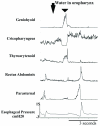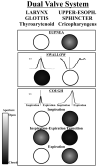Coordination of cough and swallow: a meta-behavioral response to aspiration
- PMID: 23998999
- PMCID: PMC3882902
- DOI: 10.1016/j.resp.2013.08.009
Coordination of cough and swallow: a meta-behavioral response to aspiration
Abstract
Airway protections is the prevention and/or removal of material by behaviors such as cough and swallow. We hypothesized these behaviors are coordinated to respond to aspiration. Anesthetized animals were challenged with simulated aspiration that induced both coughing and swallowing. Electromyograms of upper airway and respiratory muscles together with esophageal pressure were recorded to identify and evaluate cough and swallow. During simulated aspiration, both cough and swallow intensity increased and swallow duration decreased consistent with rapid pharyngeal clearance. Phase restriction between cough and swallow was observed; swallow was restricted to the E2 phase of cough. These results support three main conclusions: 1) the cough and swallow pattern generators are tightly coordinated so as to generate a protective meta-behavior; 2) the trachea provides feedback on swallow quality, informing the brainstem about aspiration incidences; and 3) the larynx and upper esophageal sphincter act as two separate valves controlling the direction of positive and negative pressures from the upper airway into the thorax.
Keywords: Airway protection; Dysphagia; Dystussia; EMG; Pharyngeal clearance; Pharynx.
Copyright © 2013 Elsevier B.V. All rights reserved.
Figures





Similar articles
-
Rapid activation of esophageal mechanoreceptors alters the pharyngeal phase of swallow: Evidence for inspiratory activity during swallow.PLoS One. 2021 Apr 2;16(4):e0248994. doi: 10.1371/journal.pone.0248994. eCollection 2021. PLoS One. 2021. PMID: 33798212 Free PMC article.
-
Strategies for the Integration of Cough and Swallow to Maintain Airway Protection in Humans.Lung. 2018 Oct;196(5):601-608. doi: 10.1007/s00408-018-0133-7. Epub 2018 Jun 20. Lung. 2018. PMID: 29926179 Free PMC article.
-
Co-ordination of cough and swallow in vivo and in silico.Exp Physiol. 2012 Apr;97(4):469-73. doi: 10.1113/expphysiol.2011.063362. Epub 2011 Dec 23. Exp Physiol. 2012. PMID: 22198014 Free PMC article. Review.
-
Sensory regulation of swallowing and airway protection: a role for the internal superior laryngeal nerve in humans.J Physiol. 2003 Jul 1;550(Pt 1):287-304. doi: 10.1113/jphysiol.2003.039966. Epub 2003 May 16. J Physiol. 2003. PMID: 12754311 Free PMC article.
-
Role of the dorsal medulla in the neurogenesis of airway protection.Pulm Pharmacol Ther. 2015 Dec;35:105-10. doi: 10.1016/j.pupt.2015.10.012. Epub 2015 Nov 5. Pulm Pharmacol Ther. 2015. PMID: 26549786 Free PMC article. Review.
Cited by
-
Voluntary Cough Airflow Differentiates Safe Versus Unsafe Swallowing in Amyotrophic Lateral Sclerosis.Dysphagia. 2016 Jun;31(3):383-90. doi: 10.1007/s00455-015-9687-1. Epub 2016 Jan 23. Dysphagia. 2016. PMID: 26803772 Free PMC article.
-
Swallowing action immediately before intravenous fentanyl at induction of anesthesia prevents fentanyl-induced coughing: a randomized controlled study.J Anesth. 2017 Apr;31(2):212-218. doi: 10.1007/s00540-016-2300-4. Epub 2017 Jan 3. J Anesth. 2017. PMID: 28050704 Clinical Trial.
-
Evidence of intermediate reticular formation involvement in swallow pattern generation, recorded optically in the neonate rat sagittally sectioned hindbrain.J Neurophysiol. 2021 Apr 1;125(4):993-1005. doi: 10.1152/jn.00623.2020. Epub 2021 Feb 10. J Neurophysiol. 2021. PMID: 33566745 Free PMC article.
-
Rapid activation of esophageal mechanoreceptors alters the pharyngeal phase of swallow: Evidence for inspiratory activity during swallow.PLoS One. 2021 Apr 2;16(4):e0248994. doi: 10.1371/journal.pone.0248994. eCollection 2021. PLoS One. 2021. PMID: 33798212 Free PMC article.
-
Neuroendocrine cells initiate protective upper airway reflexes.Science. 2024 Apr 19;384(6693):295-301. doi: 10.1126/science.adh5483. Epub 2024 Apr 18. Science. 2024. PMID: 38669574
References
-
- Ali GN, Laundl TM, Wallace KL, deCarle DJ, Cook IJS. Influence of cold stimulation on the normal pharyngeal swallow response. Dysphagia. 1996a;11:2–8. - PubMed
-
- Ali GN, Wallace KL, Schwartz R, DeCarle DJ, Zagami AS, Cook IJ. Mechanisms of oral-pharyngeal dysphagia in patients with Parkinson’s disease. Gastroenterology. 1996b;110:383–392. - PubMed
-
- Aviv JE, Martin JH, Sacco RL, Zagar D, Diamond B, Keen MS, Blitzer A. Supraglottic and pharyngeal sensory abnormalities in stroke patients with dysphagia. Annals of Otology, Rhinology and Laryngology. 1996;105:92–97. - PubMed
-
- Aviv JE, Sacco RL, Mohr JP, Thompson JL, Levin B, Sunshine S, Thomson J, Close LG. Laryngopharyngeal sensory testing with modified barium swallow as predictors of aspiration pneumonia after stroke. Laryngoscope. 1997;107:1254–1260. - PubMed
-
- Aviv JE, Spitzer J, Cohen M, Ma G, Belafsky P, Close LG. Laryngeal adductor reflex and pharyngeal squeeze as predictors of laryngeal penetration and aspiration. Laryngoscope. 2002;112:338–341. - PubMed
Publication types
MeSH terms
Grants and funding
LinkOut - more resources
Full Text Sources
Other Literature Sources
Medical

